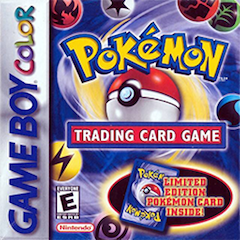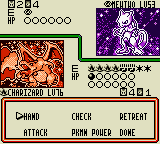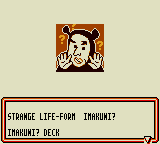

Title: |
|
Genre: |
|
|
Developer: |
|
|
Publisher: |
|
Release Date: |
|
On Wikipedia: |
|
Systems: |
|
Notable Redeeming Factor: |
|
This review comes in two parts. The first part was written in April 22 2014, the part at the bottom was written in 2020. Also, the box art shown above is from Wikipedia.
Original review as written April 22 2014:
The Pokémon Trading Card Game Game Boy game, released at the height of the Pokémon craze in early 2000, was a Game Boy game that brought the card game (based on the game) back to the Game Boy. While the whole "Pokémon: The Card Game: The Video Game" is a bit of a stretch, it does work and work well. Dr. Mason (analogous to Professor Oak) gives you initially a crummy deck but helps you defeat the 8 Club Masters and then the Grand Masters, all for the "Legendary Cards" that you get at the end. At the time, all the sets released in America were in the game, plus some extra cards exclusive the Game Boy game (though all of them, to my knowledge, were released in Japan).

Graphics are hampered by the poor color
depth of the Game Boy, but the music is catchy. (Source: Vizzed.net)
The Club Masters and their acolytes aren't much of a challenge, admittedly. They all have one theme each (electricity, psychic, grass, poison, etc.) for the most part, making them laughably easy to defeat with the right deck (that theirs has a weakness to). About half the time, they'll throw a curveball which makes it a bit of a challenge, but it's still undermined by the poor AI (they will sometimes go whole turns without attacking).
If that was too hard (remember, you start with a poor deck), Dr. Mason is always sending you booster packs, and then there's a major game breaker: Imakuni?.
Imakuni? (yes, with the question mark) is based after a real person, and in the game, he wears a black bodysuit with "ears" (based after a real costume he wore during that time: at the time, video game magazines reported Imakuni?'s name to mean "mouse man", though that is incorrect). His deck has Psyduck, Drowzee, and their respective evolutions. As the AI and their decks are rather bad, this is exacerbated in Imakuni?'s case, as in his deck, he has four "Imakuni?" Trainer cards, which confuses your own (in this case, his) Pokémon. Defeating Imakuni? will get you one of these cards (you get up to four, and the flavor text for the Imakuni? card is entertaining, if a bit creepy), but other times, he gives you four booster packs: an extremely generous offering. You can fight Imakuni? as many times as you like.

The mystery man himself. (Source: Talking-Time.net)
After you beat the game, Dr. Mason will invent a Challenge Machine that has you playing multiple opponents on one deck. This is the only part of the game that actually presents, you know, a real challenge. Even though it only remembers one game at a time, the Challenge Machine always keeps a record of the person who had the most consecutive wins (permanently, even if you wipe the file--in my case, it's my brother).
Of course, there are some problems: at the time, it had all the sets in the U.S. (Fossil, Base Set, and Jungle), so it was rather modern and cool. Within just a few months, the Team Rocket expansion was released, and it has gone downhill ever since (the game's relevance, that is). It also forces the "trading" gimmick: to get all the cards in the game, four promos are only accessible with hooking up to a second player. A second player playing with a Game Link cable is a blast, though I've never actually gotten the chance. With a human opponent, you have the chance of creating a deck that would work in the Pokémon TCG League, plus having someone that's not a pushover. It's not a replacement for the TCG either: although the game takes the gruntwork out of playing (like shuffling, laying out Prize cards), you have to put up with dialogue boxes to see what the card actually says, or looking at ultra low-res scans of cards.
There was a sequel released in Japan, but sadly it was never released in the West. The basic plotline throws you (the player character, and there's a new female playable character as well) into a mission to save the world and cards from Great Team Rocket, a group of masked goons who you'll fight (and no, they look nothing like their regular Pokémon counterparts). It has the Team Rocket and much of the Japanese Vending Machine series, as well as the original cards, but is not backwards compatible with the original in any way, and was generally forgotten. Sadly, that's the end of the legacy: would've been nice to keep having games, all with trading functionality and improved graphics.
Update added from October 31 2020:
Maybe it was the whole lousy year that I felt that I could sink my teeth into a game that I've played before and written about this game before, which is still mostly accurate (though there are two "Card Pop" exclusive cards, not four).
While it's fun to blast through the game and try new things (like getting a draw, which is rarely heard or identified properly), it's not perfect, even for what was available at the time. There are a few cards that were released in the U.S. by that time but didn't make it in, with Fossil Ditto and Base Set Electrode not making it due to their unconventional Pokémon Powers. The only other change (that was not a bug--most notably Psychic types get double damage on Confusion, which is not supposed to happen) is no drawing two on a mulligan (making novelty decks like "Mulligan Mewtwo" not function correctly), which were the rules at the time.
The other immediate weakness I saw was there's no real post-game either. You can finish collecting cards through just grinding away, you can collect a few promos through trades (although a few are permanently missable), and you can blow away the "legendary" players with a deck to counter theirs (you can switch decks between players), but due to their specialized cards or unfortunate RNG means that they (like other players) can get the jump on you. Rod, the "Lance" of the game's "Elite Four" (complete with Dragon-themed Pokémon) is either going to be a pushover or a major problem, as unlike the others, he can't send his flagship Legendary card into play immediately, but his deck has no real weaknesses and he can send his Charizard out for the barbecue.
I think that the second game proved, as I had played last year that there's not a lot where the game can really go (even aside from additional cards, which destroyed the meta).
FINAL RATING: 
Box art from Wikipedia